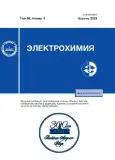Том 59, № 4 (2023)
- Жылы: 2023
- Мақалалар: 7
- URL: https://journals.rcsi.science/0424-8570/issue/view/8059
Бүкіл шығарылым
Specific Features of the Electronic Structure of Oxygen-Deficient Perovskites SrFe1 – xMoxO3 – y
Аннотация
By using the VASP package, within the framework of the DFT approach, the properties of the ground state of the SrFe1 – xMoxO3 – y oxide with the perovskite structure are calculated for the various values of molybdenum content and oxygen nonstoichiometry. It is shown that the doping procedure as well as the procedure of varying the oxygen content give rise to changes in the charge stage of oxygen ions in the system, which is accompanied by a shift of the Fermi level with respect to the invariant band structure (rigid band model) and the transition to the semimetal conduction type.
 187-192
187-192


Oxygen-Ionic Conductivity in Isovalent-Doped Layered BaLaInO4-Based Perovskites
Аннотация
The oxygen-ionic conductivity of isovalent-doped complex oxides characterized by the Ruddlesden–Popper structure is studied. The BaLa0.9Nd0.1InO4 sample was obtained for the first time by substitution in the La sublattice, and its transport properties are studied. A comparing of the results with the data for samples obtained earlier by isovalent substitution in the In-sublattice of BaLaInO4 is presented. The introducing of a dopant is shown to lead to increase in the contribution from oxygen-ionic conductivity and also in the total conductivity by ~2 orders of magnitude.
 193-199
193-199


Ionic (O2– and H+) Transport in Oxygen-Deficient Perovskites La2Me+3ZnO5.5
Аннотация
The paper is devoted to the study of the conduction mechanism in perovskite phases with composition La2Me+3ZnO5.5 (Me+3 = Al3+, Sc3+, In3+). The phases were synthesized by a standard ceramic technique in the 700–1300°C temperature range. The structure of the La2InZnO5.5 and La2ScZnO5.5 samples is orthorhombic, while the La2AlZnO5.5 sample crystallizes in the cubic symmetry. The electrical conductivity of La2Me+3ZnO5.5 (Me+3 = Al3+, Sc3+, In3+) samples is studied as a function of temperature (200–900°C), oxygen partial pressure pO2, and humidity pH2O. The complex oxides are found to have a mixed type of conduction in air, the electronic contribution (the p-type conduction) increases with increasing temperature. The phases exhibit the dominant oxygen-ion transport at temperatures below 500°C. In wet atmosphere, Sc3+- and In3+-containing samples are capable of incorporating water from gas phase and forming proton defects. No significant proton transport in the La2AlZnO5.5 sample is realized. The partial conductivities σH+, σO2−, σh in a wide range of temperatures and рО2 are discussed.
 200-207
200-207


Conductivity of Composites MeWO4–Al2O3 (Me = Ca, Sr)
Аннотация
Composites (1 – x)MeWO4–xАl2O3 (Me = Ca, Sr) are synthesized by the solid-phase method. Their phase composition and thermodynamic stability are confirmed by the XRD and TG-DSC data, respectively. Their morphology is studied by the SEM-EDA method. The conductivity of composites is studied by the method of electrochemical impedance spectroscopy as a function of the temperature, the gas-phase oxygen pressure, and the content of added disperse Аl2O3. It is shown that composites (1 – x)MeWO4–xАl2O3 (Me = Ca, Sr) are ionic conductors and their conductivity is 4–12 times higher as compared with the corresponding tungstates.
 208-215
208-215


Synthesis and Conductivity of Heterogeneous Compositions Bi4V2 – хFeхO11 – d/n% FeOу (m% Al2O3)
Аннотация
The structure and electrophysical characteristics of Bi4V2 – хFeхO11 – δ (BIFEVOX, where х = 0.3, 0.5) and its heterogeneous mixtures Bi4V2 – хFeхO11 – δ/n% FeOy and Bi4V2 – хFeхO11 – δ/m% Al2O3 are studied by varying their composition and the thermodynamic parameters of the environment. The crystallochemical parameters of individual compounds are calculated. The phase and elemental composition of samples is assessed using the XRD method and the scanning electron microscopy with energy-dispersive spectroscopic microanalysis; for individual phases, the absence of phase transitions is observed. The conductivity of materials is studied by the impedance spectroscopy. No composite effect is observed in these systems.
 216-224
216-224


One-Step Plasma-Assisted Electrochemical Synthesis of Nanocomposites of Few-Layer Graphene Structures with Manganese Oxides as Electrocatalysts for Oxygen Reduction Reaction
Аннотация
Using the method of plasma-assisted electrochemical exfoliation of graphite, a nanocomposite, which consists of few-layer graphene structures with surface decorated with manganese oxides nanoparticles, is synthesized in one-step process. It is found that this material exhibits a high electrocatalytic activity towards the oxygen reduction reaction due to the presence of manganese in the +2 and +3 oxidation states, and also carbonyl (quinone) functional groups on the surface of graphene structures.
 225-234
225-234


Sulfonated Anthraquinone-Based Ionic Complexes as a Promising Organic Negolyte for Redox-Flow Batteries
Аннотация
Due to its high solubility and fast kinetics of redox reactions, anthraquinone-2,7-disulfonic acid is a promising electroactive molecule for redox-flow-battery electrolytes and other energy applications. However, its widespread use is currently limited, primarily due to its tendency to chemical side-reactions and the formation of quinhydrone complexes between the molecule’s different redox-forms. The possibility of overcoming these shortcomings by using a simple anthraquinone-2,7-disulfonic acid functionalization with the poly(diallyldimethylammonium) polycation is studied. The ionic complexes are shown to be formed in this mixture, which leads to the suppression of the quinhydrone compound formation. At the same time, the poly(diallyldimethylammonium)/anthraquinone-2,7-disulfonic acid mixtures retain their redox activity and can be used as a negolyte in anthraquinone–bromine redox flow batteries, while all key characteristics of such a battery are comparable with those of anthraquinone–bromine redox flow batteries which used anthraquinone-2,7-disulfonic acid without any additives. The poly(diallyldimethylammonium)/anthraquinone- 2,7‑disulfonic acid-based battery (0.1 M anthraquinone-2,7-disulfonic acid) has the power density of 105 and 65 mW/cm2 for the battery state-of-charge values 100% and 50%, respectively; the energy efficiency for five charging–discharging cycles, 57.4%. In the future, the composition of the poly(diallyldimethylammonium)/anthraquinone-2,7-disulfonic acid ionic complexes can be optimized, in order to maintain good kinetics and solubility of anthraquinone-2,7-disulfonic acid and at the same time reduce the intensity of chemical side-reactions, including quinhydrone-complexes formation.
 235-246
235-246











